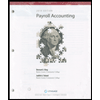
ADVANCED FIN. ACCT. LL W/ACCESS>CUSTOM<
12th Edition
ISBN: 9781265074623
Author: Christensen
Publisher: MCG CUSTOM
expand_more
expand_more
format_list_bulleted
Question
Chapter 19, Problem 19.14Q
To determine
Introduction : Voluntary health and welfare organizations (VHWOs) provide a variety of social services. These organizations withdrawn funds from the community in large amount and typically provide services with a nominal amount to those with the ability to pay or free of cost to those who cannot pay. The federal government generally provides tax exempted status to these organizations.
The reason of VHWOs not report all pledges received in the period in assets without donor restrictions in the statement of activities and identify what is not included.
Expert Solution & Answer
Want to see the full answer?
Check out a sample textbook solution
Students have asked these similar questions
One company might depreciate a new computer over three years while another company might depreciate the same model computer over five years...and both companies are right.
True
False
no chatgpAccumulated Depreciation will appear as a deduction within the section of the balance sheet labeled as Property, Plant and Equipment.
True
False
No ai Depreciation Expense is shown on the income statement in order to achieve accounting's matching principle.
True
False
Chapter 19 Solutions
ADVANCED FIN. ACCT. LL W/ACCESS>CUSTOM<
Ch. 19 - Prob. 19.1QCh. 19 - Prob. 19.2QCh. 19 - Prob. 19.3QCh. 19 - Prob. 19.4QCh. 19 - Prob. 19.5QCh. 19 - Prob. 19.6QCh. 19 - Prob. 19.7QCh. 19 - Prob. 19.8QCh. 19 - Prob. 19.9QCh. 19 - Prob. 19.10Q
Ch. 19 - Prob. 19.11QCh. 19 - Prob. 19.12QCh. 19 - Prob. 19.13QCh. 19 - Prob. 19.14QCh. 19 - Prob. 19.15QCh. 19 - Prob. 19.16QCh. 19 - Prob. 19.17QCh. 19 - Prob. 19.18QCh. 19 - Should a rotary club, an ONPO, report depreciation...Ch. 19 - Prob. 19.20QCh. 19 - Prob. 19.1CCh. 19 - Prob. 19.2CCh. 19 - Prob. 19.3CCh. 19 - Prob. 19.4CCh. 19 - Prob. 19.5CCh. 19 - Prob. 19.7CCh. 19 - Prob. 19.1.1ECh. 19 - Prob. 19.1.2ECh. 19 - Prob. 19.1.3ECh. 19 - Prob. 19.1.4ECh. 19 - Prob. 19.1.5ECh. 19 - Prob. 19.1.6ECh. 19 - Prob. 19.2.1ECh. 19 - Prob. 19.2.2ECh. 19 - Prob. 19.2.3ECh. 19 - Prob. 19.2.4ECh. 19 - Prob. 19.2.5ECh. 19 - Prob. 19.2.6ECh. 19 - Prob. 19.2.7ECh. 19 - Prob. 19.2.8ECh. 19 - Prob. 19.2.9ECh. 19 - Prob. 19.2.10ECh. 19 - Prob. 19.2.11ECh. 19 - Prob. 19.2.12ECh. 19 - Prob. 19.3ECh. 19 - Prob. 19.4ECh. 19 - Prob. 19.5.1ECh. 19 - Prob. 19.5.2ECh. 19 - Prob. 19.5.3ECh. 19 - Prob. 19.5.4ECh. 19 - Prob. 19.5.5ECh. 19 - Prob. 19.5.6ECh. 19 - Prob. 19.5.7ECh. 19 - Prob. 19.5.8ECh. 19 - Prob. 19.5.9ECh. 19 - Prob. 19.6ECh. 19 - Prob. 19.7ECh. 19 - Prob. 19.8.1ECh. 19 - Prob. 19.8.2ECh. 19 - Prob. 19.8.3ECh. 19 - Prob. 19.8.4ECh. 19 - Prob. 19.8.5ECh. 19 - Prob. 19.8.6ECh. 19 - Prob. 19.8.7ECh. 19 - Prob. 19.8.8ECh. 19 - Prob. 19.8.9ECh. 19 - Prob. 19.8.10ECh. 19 - Prob. 19.9ECh. 19 - Prob. 19.10PCh. 19 - Prob. 19.11PCh. 19 - Prob. 19.12PCh. 19 - Prob. 19.13PCh. 19 - Prob. 19.14PCh. 19 - Prob. 19.15PCh. 19 - Prob. 19.16PCh. 19 - Prob. 19.17PCh. 19 - Prob. 19.18PCh. 19 - Prob. 19.19PCh. 19 - Prob. 19.20PCh. 19 - Prob. 19.21PCh. 19 - Prob. 19.22PCh. 19 - Prob. 19.23PCh. 19 - Prob. 19.24.1PCh. 19 - Prob. 19.24.2PCh. 19 - Prob. 19.24.3PCh. 19 - Prob. 19.24.4PCh. 19 - Prob. 19.24.5PCh. 19 - Prob. 19.24.6PCh. 19 - Prob. 19.24.7PCh. 19 - Prob. 19.24.8PCh. 19 - Prob. 19.24.9PCh. 19 - Prob. 19.24.10PCh. 19 - Prob. 19.24.11PCh. 19 - Prob. 19.24.12PCh. 19 - Prob. 19.24.13PCh. 19 - Prob. 19.24.14PCh. 19 - Prob. 19.24.15PCh. 19 - Prob. 19.24.16PCh. 19 - Prob. 19.24.17PCh. 19 - Prob. 19.24.18PCh. 19 - Prob. 19.24.19PCh. 19 - Prob. 19.24.20PCh. 19 - Prob. 19.25PCh. 19 - Prob. 19.26P
Knowledge Booster
Similar questions
- no aiOne company might depreciate a new computer over three years while another company might depreciate the same model computer over five years...and both companies are right. True Falsearrow_forwardno ai An asset's useful life is the same as its physical life? True Falsearrow_forwardno ai Depreciation Expense reflects an allocation of an asset's original cost rather than an allocation based on the economic value that is being consumed. True Falsearrow_forward
- The purpose of depreciation is to have the balance sheet report the current value of an asset. True Falsearrow_forwardDepreciation Expense shown on a company's income statement must be the same amount as the depreciation expense on the company's income tax return. True Falsearrow_forwardDont use AI Give soln.arrow_forward
arrow_back_ios
SEE MORE QUESTIONS
arrow_forward_ios
Recommended textbooks for you
- Century 21 Accounting Multicolumn JournalAccountingISBN:9781337679503Author:GilbertsonPublisher:CengageBusiness/Professional Ethics Directors/Executives...AccountingISBN:9781337485913Author:BROOKSPublisher:CengageBusiness Its Legal Ethical & Global EnvironmentAccountingISBN:9781305224414Author:JENNINGSPublisher:Cengage

 Auditing: A Risk Based-Approach to Conducting a Q...AccountingISBN:9781305080577Author:Karla M Johnstone, Audrey A. Gramling, Larry E. RittenbergPublisher:South-Western College Pub
Auditing: A Risk Based-Approach to Conducting a Q...AccountingISBN:9781305080577Author:Karla M Johnstone, Audrey A. Gramling, Larry E. RittenbergPublisher:South-Western College Pub

Century 21 Accounting Multicolumn Journal
Accounting
ISBN:9781337679503
Author:Gilbertson
Publisher:Cengage

Business/Professional Ethics Directors/Executives...
Accounting
ISBN:9781337485913
Author:BROOKS
Publisher:Cengage

Business Its Legal Ethical & Global Environment
Accounting
ISBN:9781305224414
Author:JENNINGS
Publisher:Cengage



Auditing: A Risk Based-Approach to Conducting a Q...
Accounting
ISBN:9781305080577
Author:Karla M Johnstone, Audrey A. Gramling, Larry E. Rittenberg
Publisher:South-Western College Pub